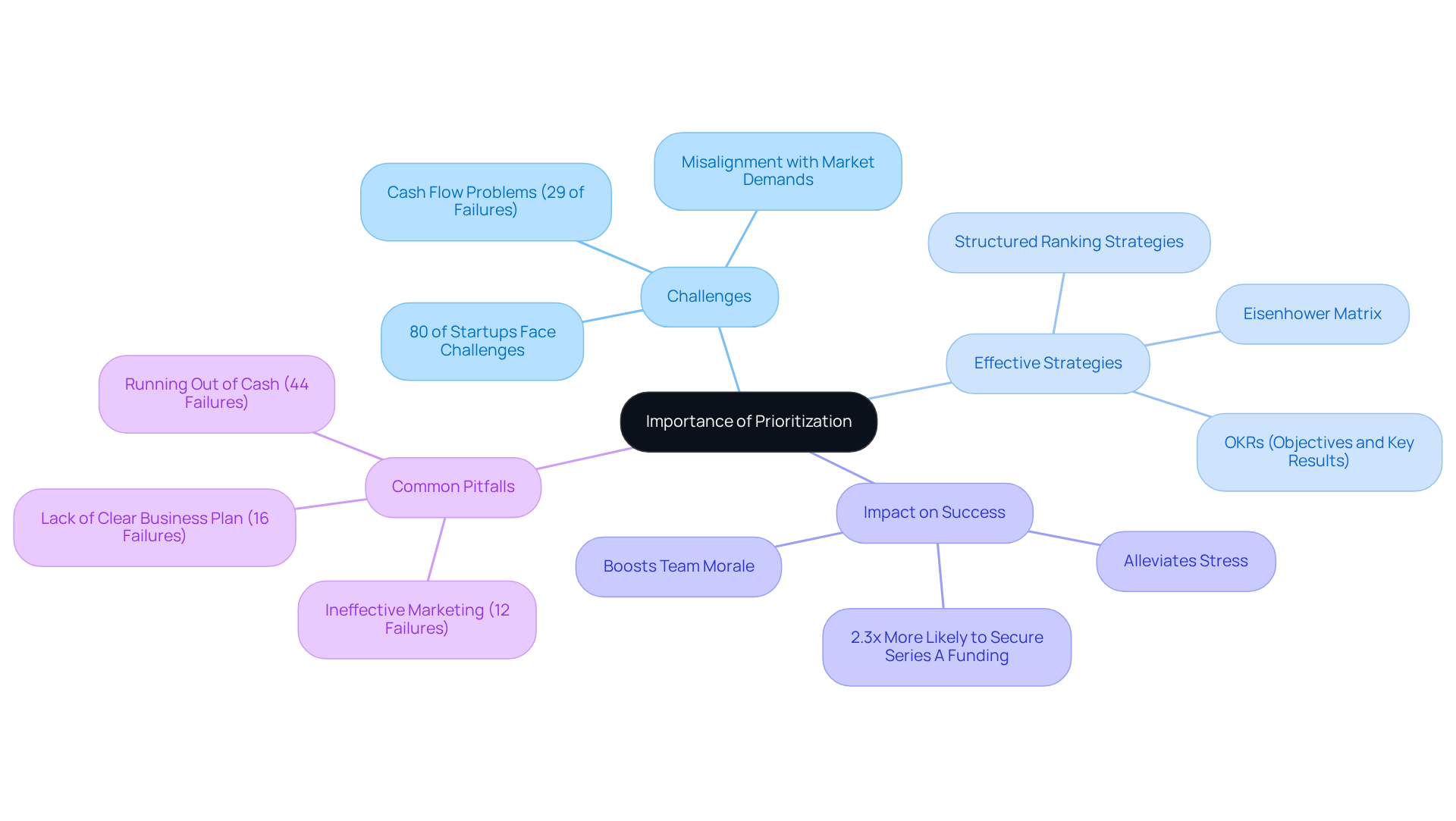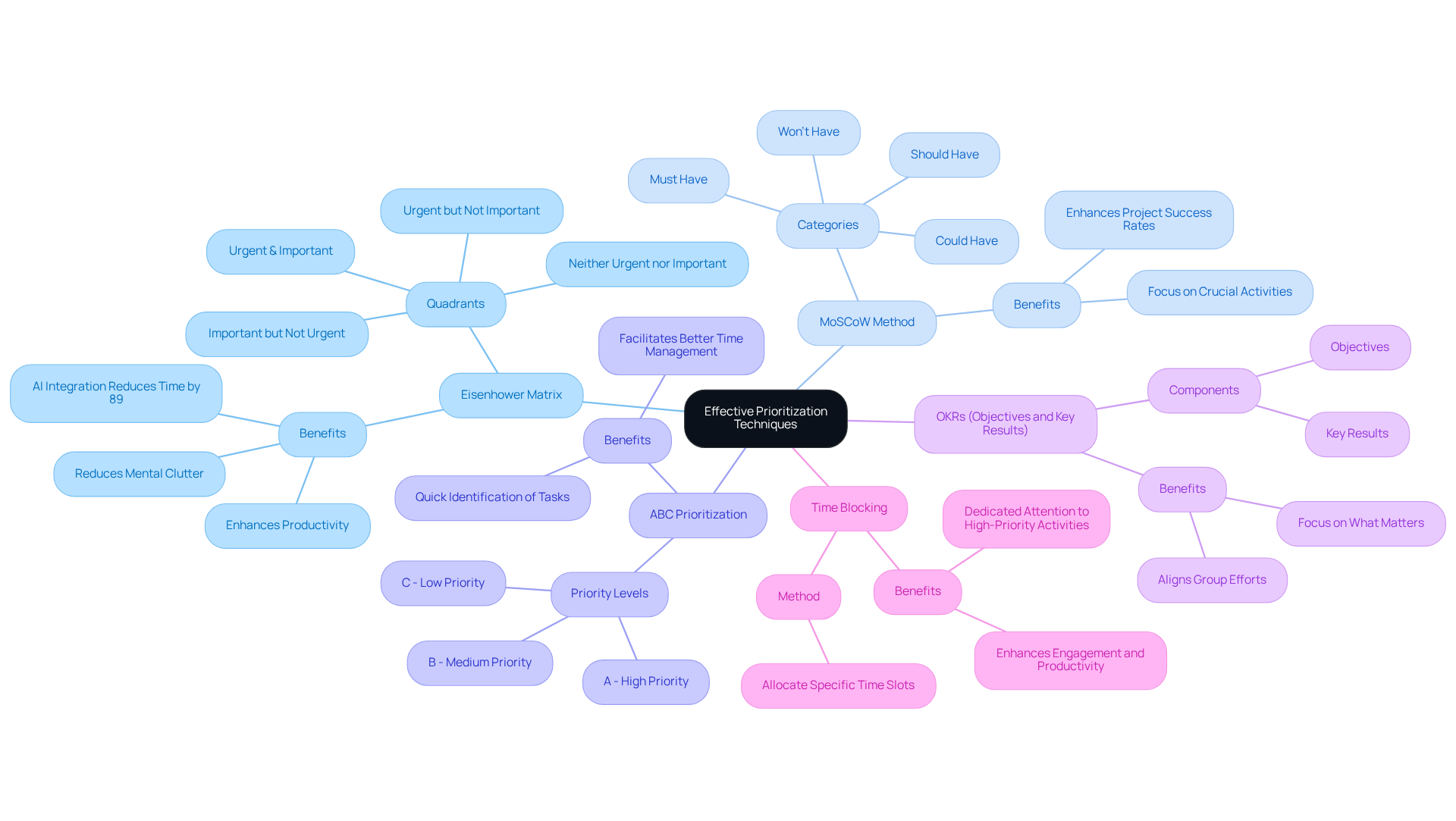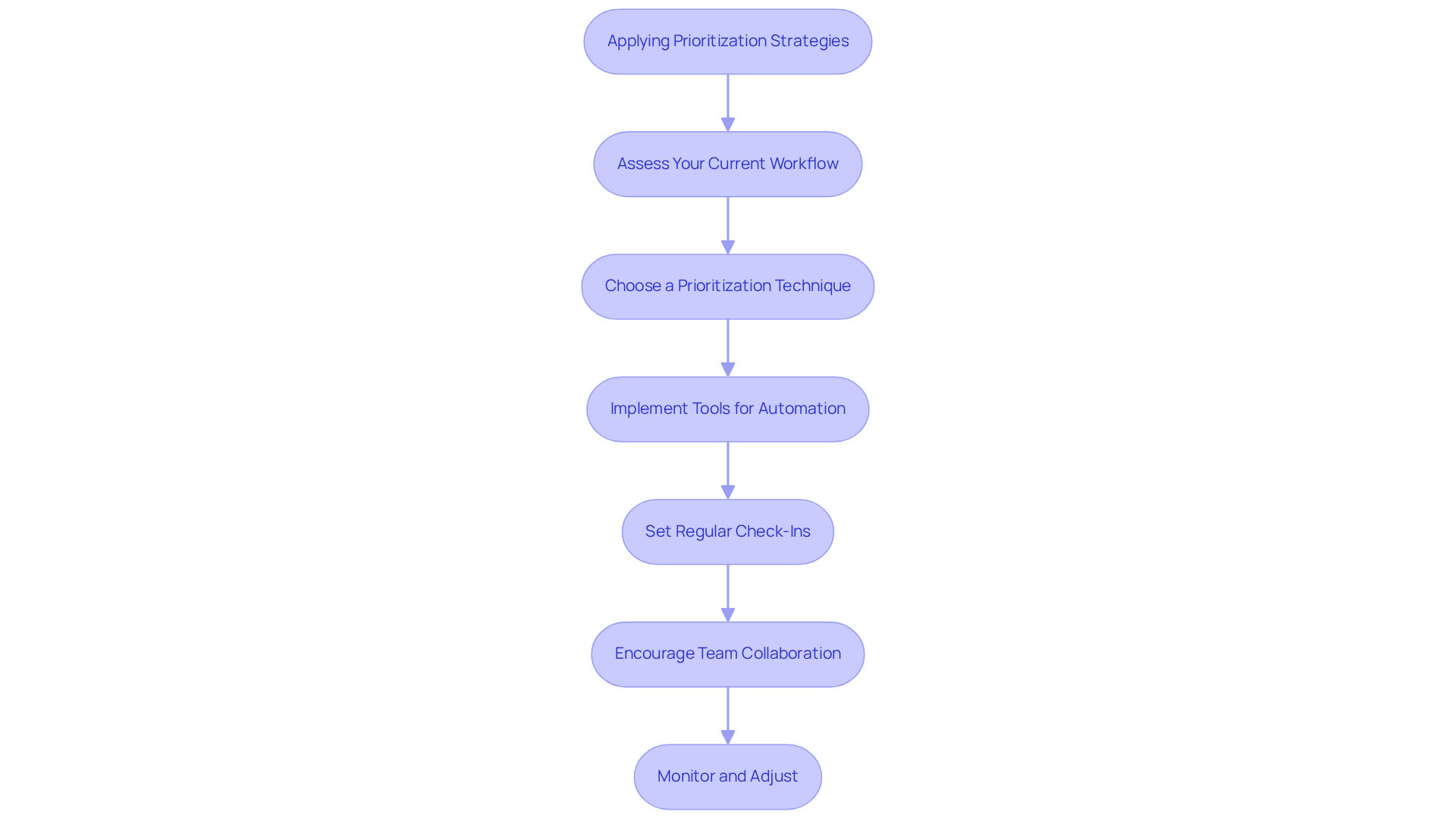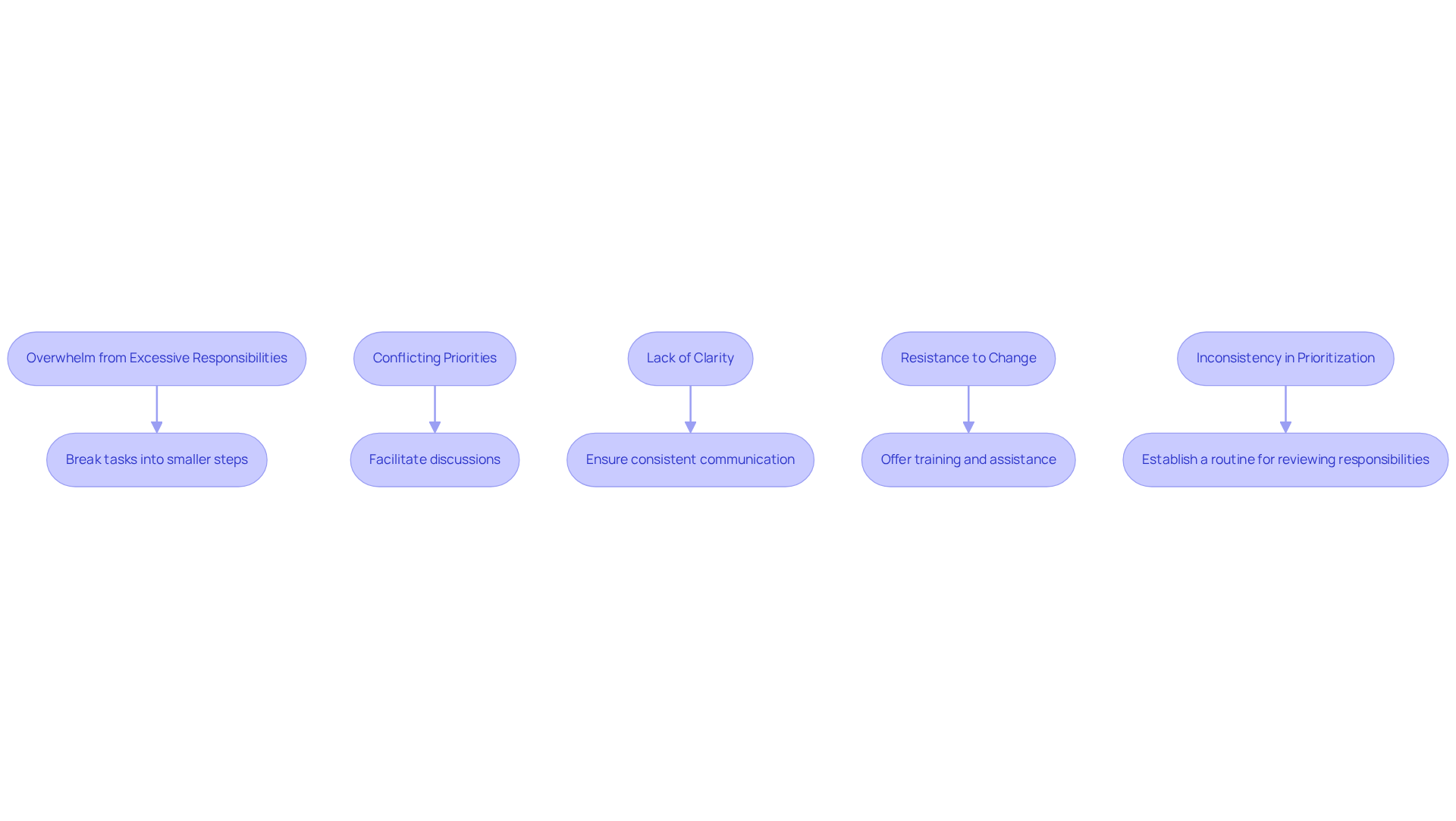Overview
The article centers on the imperative of effective work prioritization to achieve startup success through a variety of strategies and techniques. It asserts that structured prioritization methods—such as the Eisenhower Matrix and OKRs—can significantly enhance productivity and align team efforts. Ultimately, these approaches aid startups in navigating challenges and bolster their chances of securing funding. Are you ready to transform your startup's approach to prioritization?
Introduction
In a world where startups encounter relentless pressure to innovate and succeed, the ability to prioritize effectively can be the decisive factor between thriving and merely surviving. With a staggering 80% of new ventures faltering due to misaligned efforts and ineffective strategies, understanding how to prioritize work is not just a skill; it is a necessity for sustainable growth.
Yet, amidst the chaos of competing demands, how can startups ensure they focus on what truly matters? This article delves into essential prioritization techniques that empower teams to navigate challenges, boost productivity, and ultimately drive their success in a competitive landscape.
Understand the Importance of Prioritization
In today’s fast-paced business landscape, understanding how do you prioritize your work is essential, as prioritization involves determining the order of activities based on their importance and urgency. With 80% of startups grappling with challenges stemming from ineffective marketing and misalignment with market demands, knowing where to focus can significantly impact success. An effective organizational strategy enables teams to understand how do you prioritize your work, ensuring that high-impact tasks receive attention first. This approach not only alleviates stress but also boosts team morale by clarifying objectives and responsibilities.
Startups that know how do you prioritize your work can navigate challenges with agility, swiftly adapting to market changes and fostering sustainable growth. For example, companies employing structured ranking strategies, such as the Eisenhower Matrix or OKRs, often see improved alignment and focus within their teams. Research indicates that new ventures with established frameworks for prioritization are 2.3 times more likely to secure Series A funding, underscoring the importance of strategic activity management.
Moreover, successful new ventures frequently exhibit resilience and a growth mindset, cultivated through the effective organization of tasks. By concentrating on activities that resonate with their core mission and customer needs, these companies can sidestep common pitfalls—such as running out of cash or misjudging market demand—which contribute to 29% and 42% of new business failures, respectively. Ultimately, mastering the art of prioritization transcends mere responsibility management; it positions the startup for enduring success in a competitive environment.

Explore Effective Prioritization Techniques
Several effective prioritization techniques can significantly streamline your workflow:
-
Eisenhower Matrix: This technique classifies activities into four quadrants according to urgency and significance. Prioritize activities that are both urgent and important first, followed by those that are significant but not urgent. This approach not only helps in managing immediate responsibilities but also ensures that long-term goals are not neglected. Studies show that using the Eisenhower Matrix can enhance productivity by reducing mental clutter and improving focus on high-impact activities. Notably, integrating AI with the Eisenhower Matrix can reduce prioritization time by 89%, making it a powerful tool for startups.
-
MoSCoW Method: This technique categorizes activities into four groups: Must have, Should have, Could have, and Won't have. By clearly outlining what is vital for project success, teams can focus their efforts on crucial activities, thereby enhancing the probability of achieving project deadlines and goals. The MoSCoW method has been shown to improve prioritization success rates, particularly in dynamic environments like startups, where adaptability is crucial.
-
ABC Prioritization: Assign an 'A' to high-priority items, 'B' to medium-priority items, and 'C' to low-priority items. This straightforward method allows for quick identification of what requires immediate attention, facilitating better time management and decision-making.
-
OKRs (Objectives and Key Results): Establish clear objectives and measurable key results to align group efforts. This framework assists in prioritizing activities that contribute to overarching goals, ensuring that all team members are focused on what truly matters for the project's success.
-
Time Blocking: Allocate specific time slots for various activities or categories of work. This method guarantees that high-priority activities receive dedicated attention without interruptions, enabling greater engagement and productivity. Studies suggest that allocating a minimum of one time slot of 2 to 3 hours weekly to essential activities can result in considerable enhancements in overall performance and satisfaction.

Apply Prioritization Strategies to Your Work Environment
To effectively implement prioritization strategies in your work environment, consider the following steps:
-
Assess Your Current Workflow: Begin by evaluating how tasks are currently managed. Are there bottlenecks? Identify areas where how do you prioritize your work is lacking to create a more efficient system.
-
Choose a Prioritization Technique: Select one or more techniques that resonate with your team's needs and culture. Which method aligns best with your objectives?
-
Implement Tools for Automation: Leverage tools like Casy to automate project creation and updates based on chat discussions. This minimizes manual input and ensures that tasks are captured in real-time, enhancing productivity.
-
Set Regular Check-Ins: Schedule weekly or bi-weekly meetings to review priorities and make necessary adjustments. This practice ensures that the group remains aligned and can effectively address how do you prioritize your work in response to evolving needs.
-
Encourage team collaboration by fostering an environment where team members can openly discuss how do you prioritize your work and negotiate priorities. This collaborative approach not only enhances buy-in but also increases accountability within the team.
-
Monitor and Adjust: Continuously assess the effectiveness of your prioritization strategies. Remain open to adjusting techniques based on feedback and changing circumstances, ensuring your approach remains relevant and effective.

Troubleshoot Common Prioritization Challenges
Even with the best strategies in place, challenges can arise. Here are some common issues and how to address them:
-
Overwhelm from Excessive Responsibilities: Are you facing an unmanageable list of duties? Revisit how do you prioritize your work in your technique. Breaking larger tasks into smaller, actionable steps can make them more manageable and less daunting.
-
Conflicting Priorities: Differing views on what is important among group members can lead to confusion. Facilitate discussions to understand how do you prioritize your work. Employ techniques like the MoSCoW method to reach a consensus on what must be done, what should be done, and what can wait.
-
Lack of Clarity: Do all group members comprehend the standards for ranking? Ensure consistent communication about how do you prioritize your work and the reasoning behind ranking choices. This promotes openness and assists everyone in remaining coordinated. Efficient communication has been associated with improved productivity; 64% of business leaders believe it has boosted their group's performance.
-
Resistance to Change: If group members are reluctant to embrace new ranking methods, what can you do? Offer training and assistance. Highlight the benefits of these techniques, such as improved workflow and reduced stress, to encourage buy-in.
-
To avoid inconsistency in prioritization, it is important to consider how do you prioritize your work by establishing a routine for reviewing and updating responsibilities. Promote responsibility by designating ownership of duties and priorities to specific individuals. This can greatly improve completion rates. Research indicates that introducing a responsibility ownership model can enhance completion rates from 70% to 90%, illustrating the effectiveness of clear accountability. Additionally, teams that prioritize tasks effectively are 1.4 times more likely to outperform their peers.

Conclusion
Mastering the art of prioritization is essential for startups striving for sustainable success in a competitive landscape. By effectively determining the order of tasks based on urgency and significance, startups can streamline operations while enhancing team morale and adaptability. This strategic focus on high-impact activities positions organizations to navigate challenges with agility, ultimately leading to better alignment with market demands and increased chances of securing vital funding.
The article outlines several effective prioritization techniques, including:
- The Eisenhower Matrix
- MoSCoW Method
- OKRs
Each offering unique benefits to help startups maintain clarity and focus. By implementing these strategies and fostering a culture of collaboration and open communication, teams can overcome common challenges such as conflicting priorities and overwhelm from excessive responsibilities. Regular assessments and adjustments to prioritization methods ensure that the approach remains relevant and effective in a constantly evolving business environment.
In summary, prioritization transcends mere task management; it is a fundamental practice that can significantly impact a startup's trajectory. By embracing effective prioritization strategies, startups can enhance productivity, reduce stress, and ultimately increase their chances of long-term success. Taking the time to implement these techniques and address potential challenges paves the way for a more organized, efficient, and resilient organization, ready to thrive amidst the uncertainties of the startup world.
Frequently Asked Questions
Why is prioritization important for businesses, especially startups?
Prioritization is essential for businesses as it helps determine the order of activities based on their importance and urgency. It allows startups to focus on high-impact tasks, alleviating stress and boosting team morale, which is crucial in a fast-paced business landscape.
What challenges do startups face related to prioritization?
About 80% of startups struggle with challenges stemming from ineffective marketing and misalignment with market demands, making it vital for them to know where to focus their efforts.
How can effective prioritization impact a startup's success?
Startups that effectively prioritize their work can navigate challenges with agility, adapt to market changes, and foster sustainable growth. This strategic focus is linked to improved alignment and focus within teams.
What are some structured strategies for prioritization?
Structured ranking strategies such as the Eisenhower Matrix or Objectives and Key Results (OKRs) are effective for prioritization, helping teams clarify objectives and responsibilities.
What evidence supports the importance of prioritization in securing funding?
Research shows that new ventures with established frameworks for prioritization are 2.3 times more likely to secure Series A funding, highlighting its significance in strategic activity management.
How does effective organization of tasks contribute to a startup's resilience?
Successful new ventures often exhibit resilience and a growth mindset, which are cultivated through the effective organization of tasks. This helps them concentrate on activities that align with their core mission and customer needs.
What common pitfalls can effective prioritization help startups avoid?
Effective prioritization can help startups sidestep common pitfalls such as running out of cash or misjudging market demand, which are significant contributors to new business failures, accounting for 29% and 42% of failures, respectively.
What is the overall benefit of mastering prioritization for startups?
Mastering the art of prioritization positions startups for enduring success in a competitive environment, transcending mere responsibility management to enhance strategic focus and operational efficiency.




